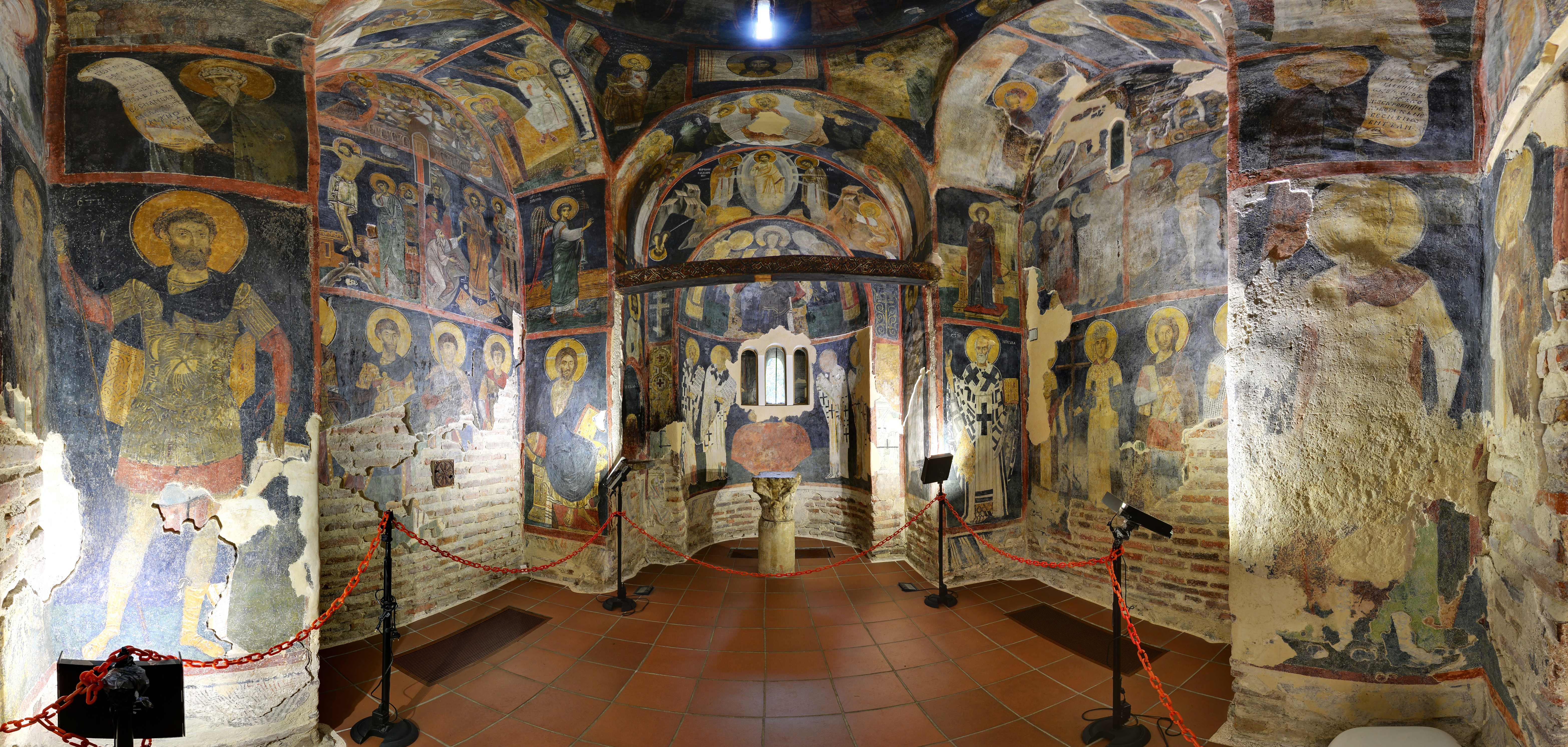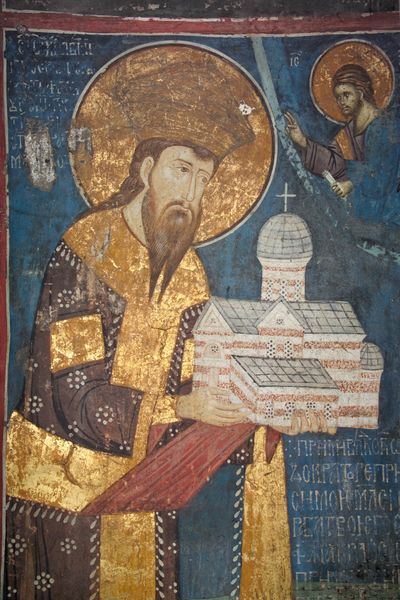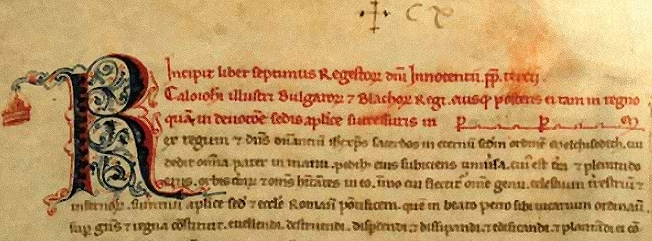|
Painting Of The Tarnovo Artistic School
The painting of the Tarnovo Artistic School was the mainstream of the Bulgarian fine arts between 13th and 14th centuries named after the capital and the main cultural center of the Second Bulgarian Empire, Tarnovo. Although it was influenced by some tendencies of the Palaeogan Renaissance in the Byzantine Empire, the Tarnovo painting had its own unique features which makes it a separate artistic school. It includes mural decoration of churches, easel painting icons, and illuminated manuscripts. A few remains of mosaics have been found during archaeological excavation which shows that this technique was only rarely used in the Bulgarian Empire. The works of that school have some degree of realism, individualised portraits and psychological insight. Illuminated manuscripts The most famous manuscripts are the Sofia Psalter, 1337, Tomić Psalter, c 1360, and the Gospels of Tsar Ivan Alexander, 1355–1356, now in Sofia, Moscow and London respectively. All are heavily illumin ... [...More Info...] [...Related Items...] OR: [Wikipedia] [Google] [Baidu] |
Fresco
Fresco (plural ''frescos'' or ''frescoes'') is a technique of mural painting executed upon freshly laid ("wet") lime plaster. Water is used as the vehicle for the dry-powder pigment to merge with the plaster, and with the setting of the plaster, the painting becomes an integral part of the wall. The word ''fresco'' ( it, affresco) is derived from the Italian adjective ''fresco'' meaning "fresh", and may thus be contrasted with fresco-secco or secco mural painting techniques, which are applied to dried plaster, to supplement painting in fresco. The fresco technique has been employed since antiquity and is closely associated with Italian Renaissance painting. The word ''fresco'' is commonly and inaccurately used in English to refer to any wall painting regardless of the plaster technology or binding medium. This, in part, contributes to a misconception that the most geographically and temporally common wall painting technology was the painting into wet lime plaster. Even in appar ... [...More Info...] [...Related Items...] OR: [Wikipedia] [Google] [Baidu] |
Asen Dynasty
The Asen dynasty ( bg, Асеневци, ''Asenevtsi'') founded and ruled a medieval Bulgarian state, called in modern historiography the Second Bulgarian Empire, between 1185 and 1280. The Asen dynasty rose as the leaders of Bulgaria after a rebellion against the Byzantine Empire at the turn of the year 1185/1186 caused by the increase in the Imperial taxes. Early rulers from the Asen dynasty (particularly Kaloyan) referred to themselves as "Emperors of Bulgarians and Vlachs". Later rulers, especially the successful Ivan Asen II, styled themselves "Tsars (Emperors) of Bulgarians and Romans". Some members of the Asen family entered Byzantine service in the thirteenth to fourteenth centuries. The name also occurs as a family name in modern Greek, and could go back to the same name. Their origin is obscure. Origins The origins of the dynasty, especially the ethnic background of the three Asen brothers ( Teodor I Peter IV, Ivan Asen I and Kaloyan) are still a source of much con ... [...More Info...] [...Related Items...] OR: [Wikipedia] [Google] [Baidu] |
Demetrius
Demetrius is the Latinized form of the Ancient Greek male given name ''Dēmḗtrios'' (), meaning “Demetris” - "devoted to goddess Demeter". Alternate forms include Demetrios, Dimitrios, Dimitris, Dmytro, Dimitri, Dimitrie, Dimitar, Dumitru, Demitri, Dhimitër, and Dimitrije, in addition to other forms (such as Russian Dmitry) descended from it. Demetrius and its variations may refer to the following: *Demetrius of Alopece (4th century BC), Greek sculptor noted for his realism *Demetrius of Phalerum ( – BC) *Demetrius, somatophylax of Alexander the Great (d. 330 BC) *Demetrius - brother of Antigonus I Monophthalmus, king of Macedonia 306-301 BC *Demetrius I of Macedon (337–283 BC), called ''Poliorcetes'', son of Antigonus I Monophthalmus, King of Macedonia 294–288 BC *Demetrius the Fair (Demetrius the Handsome, Demetrius of Cyrene) (285 BC-249/250 BC) - Hellenistic king of Cyrene *Demetrius II Aetolicus, son of Antigonus II, King of Macedonia 239–229 BC *D ... [...More Info...] [...Related Items...] OR: [Wikipedia] [Google] [Baidu] |
Boyana Church
The Boyana Church ( bg, Боянска църква, ''Boyanska tsărkva'') is a medieval Bulgarian Orthodox church situated on the outskirts of Sofia, the capital of Bulgaria, in the Boyana quarter. In 1979, the building was added to the UNESCO World Heritage List. The east wing of the two-story church was originally constructed in the late 10th or early 11th century, then the central wing was added in the 13th century under the Second Bulgarian Empire, the whole building being finished with a further expansion to the west in the middle of the 19th century. A total of 89 scenes with 240 human images are depicted on the walls of the church. History and architecture The Boyana Church was built in three stages: in the late 10th to early 11th, the mid-13th, and the mid-19th centuries. The oldest section (the eastern church) is a small one-apse cross-vaulted church with inbuilt cruciform supports. It was built in the late 10th or the early 11th century. The second section, which a ... [...More Info...] [...Related Items...] OR: [Wikipedia] [Google] [Baidu] |
Ktitor
''Ktetor'' ( el, κτήτωρ) or ''ktitor'' (; ka, ქტიტორი ''kt’it’ori''; ro, ctitor), meaning "founder", is a title given in the Middle Ages to the provider of funds for construction or reconstruction of an Eastern Orthodox church or monastery, for the addition of icons, frescos, and other works of art. It was used in the Byzantine sphere. A Catholic equivalent of the term is "donator". At the time of founding, the ktetor often issued typika, and was illustrated on fresco Fresco (plural ''frescos'' or ''frescoes'') is a technique of mural painting executed upon freshly laid ("wet") lime plaster. Water is used as the vehicle for the dry-powder pigment to merge with the plaster, and with the setting of the plaste ...es ("ktetor portrait"). The female form is ''ktetorissa'' ( el, κτητόρισσα) or ''ktitoritsa'' (). Sources * * History of Eastern Orthodoxy Philanthropy Byzantine culture Greek words and phrases {{Orthodoxy-stub ... [...More Info...] [...Related Items...] OR: [Wikipedia] [Google] [Baidu] |
Marble
Marble is a metamorphic rock composed of recrystallized carbonate minerals, most commonly calcite or Dolomite (mineral), dolomite. Marble is typically not Foliation (geology), foliated (layered), although there are exceptions. In geology, the term ''marble'' refers to metamorphosed limestone, but its use in stonemasonry more broadly encompasses unmetamorphosed limestone. Marble is commonly used for Marble sculpture, sculpture and as a building material. Etymology The word "marble" derives from the Ancient Greek (), from (), "crystalline rock, shining stone", perhaps from the verb (), "to flash, sparkle, gleam"; Robert S. P. Beekes, R. S. P. Beekes has suggested that a "Pre-Greek origin is probable". This Stem (linguistics), stem is also the ancestor of the English language, English word "marmoreal," meaning "marble-like." While the English term "marble" resembles the French language, French , most other European languages (with words like "marmoreal") more closely resemb ... [...More Info...] [...Related Items...] OR: [Wikipedia] [Google] [Baidu] |
Saint
In religious belief, a saint is a person who is recognized as having an exceptional degree of Q-D-Š, holiness, likeness, or closeness to God. However, the use of the term ''saint'' depends on the context and Christian denomination, denomination. In Catholic Church, Catholic, Eastern Orthodox Church, Eastern Orthodox, Anglican Communion, Anglican, Oriental Orthodox, and Lutheranism, Lutheran doctrine, all of their faithful deceased in Heaven are considered to be saints, but some are considered worthy of greater honor or emulation. Official ecclesiastical recognition, and consequently a public cult of veneration, is conferred on some denominational saints through the process of canonization in the Catholic Church or glorification in the Eastern Orthodox Church after their approval. While the English word ''saint'' originated in Christianity, History of religion, historians of religion tend to use the appellation "in a more general way to refer to the state of special holiness t ... [...More Info...] [...Related Items...] OR: [Wikipedia] [Google] [Baidu] |
Kalojan Desislava
Kaloyan or Kalojan, also known as Ioannitsa or Johannitsa ( bg, Калоян, Йоаница; 1170 – October 1207), was emperor or tsar of Bulgaria from 1196 to 1207. He was the younger brother of Theodor and Asen, who led the anti-Byzantine uprising of the Bulgarians and Vlachs in 1185. The uprising ended with the restoration of Bulgaria as an independent state. He spent a few years as a hostage in Constantinople in the late 1180s. Theodor, crowned Emperor Peter II, made him his co-ruler after Asen was murdered in 1196. A year later, Peter was also murdered, and Kaloyan became the sole ruler of Bulgaria. To obtain an imperial title from the Holy See, Kaloyan entered into correspondence with Pope Innocent III, offering to acknowledge papal primacy. His expansionist policy brought him into conflict with the Byzantine Empire, Hungary, and Serbia. In 1204, King Emeric of Hungary allowed the papal legate who was to deliver a royal crown to Kaloyan to enter Bulgaria only at the ... [...More Info...] [...Related Items...] OR: [Wikipedia] [Google] [Baidu] |
Plinth From Forty Martyrs Church
A pedestal (from French ''piédestal'', Italian ''piedistallo'' 'foot of a stall') or plinth is a support at the bottom of a statue, vase, column, or certain altars. Smaller pedestals, especially if round in shape, may be called socles. In civil engineering, it is also called ''basement''. The minimum height of the plinth is usually kept as 45 cm (for buildings). It transmits loads from superstructure to the substructure and acts as the retaining wall for the filling inside the plinth or raised floor. In sculpting, the terms base, plinth, and pedestal are defined according to their subtle differences. A base is defined as a large mass that supports the sculpture from below. A plinth is defined as a flat and planar support which separates the sculpture from the environment. A pedestal, on the other hand, is defined as a shaft-like form that raises the sculpture and separates it from the base. An elevated pedestal or plinth that bears a statue, and which is raised from th ... [...More Info...] [...Related Items...] OR: [Wikipedia] [Google] [Baidu] |
Canon Law
Canon law (from grc, κανών, , a 'straight measuring rod, ruler') is a set of ordinances and regulations made by ecclesiastical authority (church leadership) for the government of a Christian organization or church and its members. It is the internal ecclesiastical law, or operational policy, governing the Catholic Church (both the Latin Church and the Eastern Catholic Churches), the Eastern Orthodox and Oriental Orthodox churches, and the individual national churches within the Anglican Communion. The way that such church law is legislated, interpreted and at times adjudicated varies widely among these four bodies of churches. In all three traditions, a canon was originally a rule adopted by a church council; these canons formed the foundation of canon law. Etymology Greek / grc, κανών, Arabic / , Hebrew / , 'straight'; a rule, code, standard, or measure; the root meaning in all these languages is 'reed'; see also the Romance-language ancestors of the Engli ... [...More Info...] [...Related Items...] OR: [Wikipedia] [Google] [Baidu] |
Horizontal Plane
In astronomy, geography, and related sciences and contexts, a '' direction'' or ''plane'' passing by a given point is said to be vertical if it contains the local gravity direction at that point. Conversely, a direction or plane is said to be horizontal if it is perpendicular to the vertical direction. In general, something that is vertical can be drawn from up to down (or down to up), such as the y-axis in the Cartesian coordinate system. Historical definition The word ''horizontal'' is derived from the Latin , which derives from the Greek , meaning 'separating' or 'marking a boundary'. The word ''vertical'' is derived from the late Latin ', which is from the same root as ''vertex'', meaning 'highest point' or more literally the 'turning point' such as in a whirlpool. Girard Desargues defined the vertical to be perpendicular to the horizon in his 1636 book ''Perspective''. Geophysical definition The plumb line and spirit level In physics, engineering and construction, th ... [...More Info...] [...Related Items...] OR: [Wikipedia] [Google] [Baidu] |
.jpg)






.jpg)
